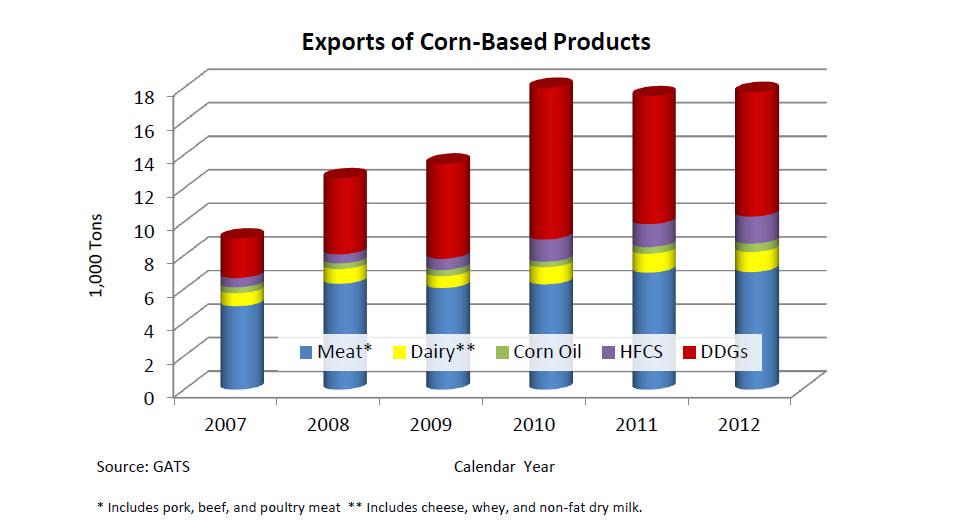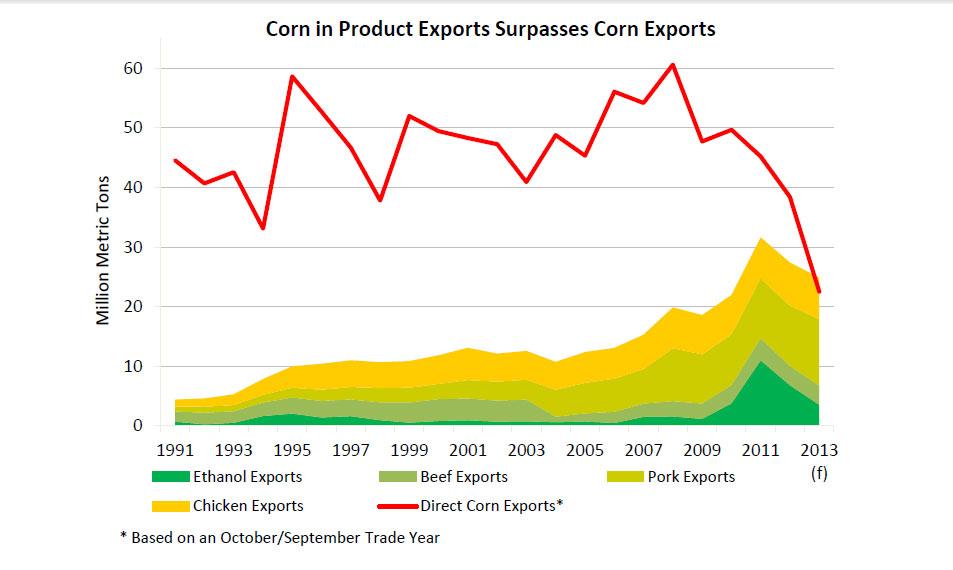For U.S. Corn, Value-Added Exports Outpace Bulk Exports
Contact:
U.S. Corn Exports Plummet…
Faced with unprecedented foreign competition, a poor harvest, and strong domestic demand from the ethanol and feed industries, U.S. corn exports are forecast to fall to 22 million tons this year1. This is a decline of more than 23 million tons from just two years ago and marks the lowest U.S. export volume in 41 years. By contrast, combined shipments from Argentina, Brazil and the Ukraine are forecast at 58.5 million tons, up nearly 27 million tons from just two years ago. Though both U.S. market share and overall export volume have fallen over the past few years, exports are expected to at least partially rebound in 2013/14 assuming normal weather conditions.
…But Value-Added Exports Double
Even as corn exports fall, shipments of products produced from corn have rapidly increased. Exports of meats, dairy products (cheese, non-fat dry milk, and whey), corn oil, corn syrup, distillers dried grains, and ethanol have increased from less than $2 billion in the 1990 calendar year to $13 billion in calendar 2012. On a volume basis, exports of these products (excluding ethanol) have doubled over the past five years, from 9 million tons to 18 million tons.

Level of Corn Used in Meat and Ethanol Exports Soars
While the chart above measures the export of products produced from corn, it is possible to measure the actual amount of corn used in the production and export of some key value-added products such as meats and ethanol.
Measuring2 the amount of corn used to produce these value-added exports reveals that corn used in the production of exported meat doubled from 2004 to 2012 (from 10.1 million tons to 20.6 million tons). Meanwhile, corn used for the production of exported ethanol3 increased from just over one million tons in 2009 to 6.8 million tons in 2012, after reaching a high of 11 million tons in 2011. Together, the amount of corn used in these value-added exports (ethanol and meat) has doubled since 2006.

Corn in Value-Added Shipments Forecast to Exceed Grain Corn Exports
The total level of corn used in exported meat and ethanol reached a record 32 million tons in 2011. The forecast for 2013 is that 25 million tons of corn will be used in the production of exported meat and ethanol. Though this level would be down from the 2011 record, due mostly to lower ethanol shipments, it would exceed – for the first time – the forecast level of corn exported in grain form (22.5 million tons).
Value-Added Corn Export Growth Expected to Continue
Global demand for U.S. meat continues to rise and according to recently released USDA baseline projections, beef, pork, and broiler exports are forecast to grow 1.2 million tons over the next decade. As a result, additional corn will be needed to produce this exported meat. Though no forecasts are available, increases in ethanol exports could further boost the overall level of value- added corn exports. Corn used in meat and ethanol exports now accounts for 10 percent of U.S. corn production, which is up from just three percent in 2004. As global demand grows for value-added corn products, particularly meats, an increasingly large portion of the U.S. crop could be exported in value-added form.
1 Unless otherwise specified, all data are presented on a October/September corn trade year basis
2 Converting meat exports into their corn equivalent is calculated through a series of conversions including estimating the live weight of animals from a given level of meat exports using dressing percentage (beef 62%, pork 72%, poultry 73%), calculating the amount of feed necessary to produce the live weight of animals using feed conversion factors (beef 7.4, pork 4.2, poultry 2.1), factoring the proportion of corn in feed rations (beef 60%, pork 78%, poultry 73%), and estimating the percentage of the lifetime gain of beef cattle in a feedlot (40%).
3 The amount of corn used to produce distillers dried grains (DDGs) exports is not included as valued-added exports since DDGs are a byproduct of the ethanol production process. The amount of corn used to produce of gallon of ethanol also produces DDGs. Therefore, including corn used in DDGs exports would be double counting.
